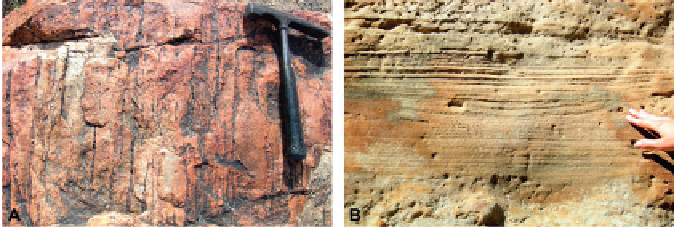Environmental Engineering Reference
In-Depth Information
individually distinct and identifiable trace fossils cannot be observed. The
parallel concept of
ichnofacies
, introduced by
Seilacher (1964, 1967)
,isan
extension of the biofacies approach by recognizing recurrent associations of
ichnotaxa that represent particular paleoenvironments or specific sets of envi-
ronmental conditions, such as bathymetry, salinity, substrate consistency, etc.
(
MacEachern et al., 2012
). In contrast to ichnofacies, ichnofabric extends
beyond a simple listing of common associations of ichnotaxa by highlighting
the broader effects of organism behavior on the substrate itself.
In the first formal use of the term “ichnofabric” in a refereed publication,
Ekdale and Bromley (1983)
exemplified the concept by illustrating in great
detail the ichnofabric of the 15-cm-thick Kjølby G
˚
rd Marl, a thoroughly bio-
turbated marly chalk layer in the uppermost Cretaceous of western Denmark.
They wrote that ichnofabric includes “those aspects of the texture and internal
structure of the bed resulting from all phases of bioturbation” (
Ekdale and
Bromley, 1983
: 110). In the glossary of an SEPM short course text on ichnology,
they further defined ichnofabric as “all aspects of the texture and internal struc-
ture of a sediment that result from bioturbation and bioerosion at all
scales; includes both bioturbation fabric and bioerosion fabric” (
Ekdale et al.,
1984a
: 308).
From that point, the practical application of the ichnofabric concept ramified
in several different, complementary directions. Some ichnofabrics may be
thought of as
simple ichnofabrics
in cases where they contain just one type
of trace fossil. In certain cases, the ichnofabric consists of a single ichnotaxon
superimposed on primary stratification with portions of the original sedimen-
tary laminae still discernible behind the trace fossils (
Fig. 1
). In other cases,
the entire bed is totally bioturbated with only a single ichnotaxon evident in
FIGURE 1
Monoichnospecific ichnofabrics in incompletely bioturbated sediment, as depicted in
these two examples, often reflect high-energy depositional environments, such as intertidal settings
(as in A) or storm-related deposits (as in B). In such situations, the interplay of sedimentation, bio-
turbation, and erosional processes is directly reflected in the resultant ichnofabrics. (A)
Skolithos
ichnofabric in the Watson Ranch Quartzite, Lower Ordovician, Confusion Range, Millard County,
Utah. (B)
Ophiomorpha
ichnofabric alternating with low-angle, cross-stratified beds in a “lam-
scram” succession (after
Ekdale, 1985a
) in the Blackhawk Formation, Upper Cretaceous, Wasatch
Plateau, Carbon County, Utah.










Search WWH ::

Custom Search